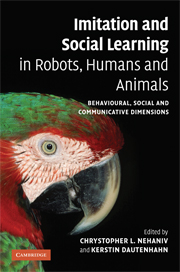 Imitation and Social Learning in Robots, Humans and Animals
Imitation and Social Learning in Robots, Humans and Animals Published online by Cambridge University Press: 10 December 2009
Introduction
The aim of this chapter is to parallel the development of imitation in a human infant and in an autonomous robot. To draw a valid comparison between the two systems – namely the infant and the robot – it is necessary to insure that their respective architectures present sufficient basic similarities. The present chapter will thus start with a description of the main features that enable a human neonate and the autonomous robot designed by the ETIS group to develop a capacity to imitate. Note that the robot is not implemented to imitate and that imitation will develop spontaneously as a result of the capacity of the robot to couple perception and action together with an imprecision in its visual perception.
Within the framework of a bottom-up perspective, we propose in the second part of the chapter to consider the development of imitation as a continuous phenomenon throughout development. Consequently, we will devote the third part of the chapter to show how basic perception–action coupling may not only account for the development of learning but also for the development of the communicative function of imitation. Exploring the communicative function of imitation is a new topic for roboticists, who classically consider imitation as a way to learn more rapidly relevant interactions within a novel environment. A model of synchronization of rhythm between two systems describes the first steps toward a communicative use of imitation.
To save this book to your Kindle, first ensure [email protected] is added to your Approved Personal Document E-mail List under your Personal Document Settings on the Manage Your Content and Devices page of your Amazon account. Then enter the ‘name’ part of your Kindle email address below. Find out more about saving to your Kindle.
Note you can select to save to either the @free.kindle.com or @kindle.com variations. ‘@free.kindle.com’ emails are free but can only be saved to your device when it is connected to wi-fi. ‘@kindle.com’ emails can be delivered even when you are not connected to wi-fi, but note that service fees apply.
Find out more about the Kindle Personal Document Service.
To save content items to your account, please confirm that you agree to abide by our usage policies. If this is the first time you use this feature, you will be asked to authorise Cambridge Core to connect with your account. Find out more about saving content to Dropbox.
To save content items to your account, please confirm that you agree to abide by our usage policies. If this is the first time you use this feature, you will be asked to authorise Cambridge Core to connect with your account. Find out more about saving content to Google Drive.